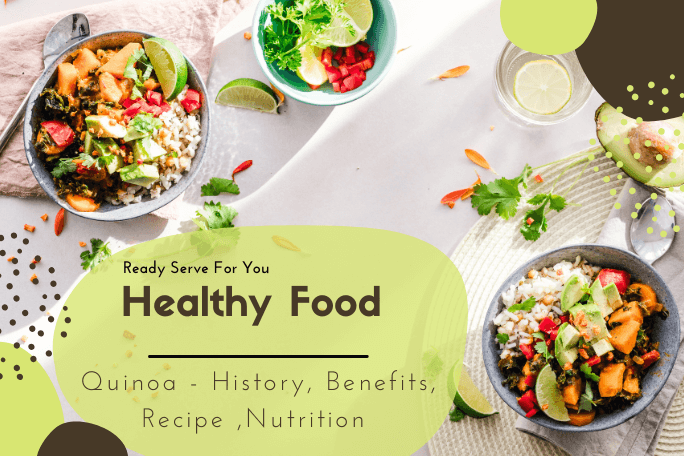Quinoa
In recent years, one plant has become miraculously popular: Quinoa. When it comes to Quinoa, many people may first think of it as a grain, similar to wheat. Although there is a “wheat” in the name, it is not “related” to grasses such as wheat in plant taxonomy and does not belong to cereal grains. So what is it?

What is Quinoa
Quinoa belongs to the Chenopodiaceae family, like spinach and beets. Quinoa has the characteristics of cold resistance, drought resistance, barren resistance, and salt-alkali tolerance. It is a crop that likes cold and high altitudes. It hardly needs fertilization and pesticides throughout the process and has natural and pollution-free characteristics.
History of Quinoa
Quinoa is native to the Andes in South America. It is the main traditional food of the Inca indigenous people. It has a history of eating and planting for more than 5,000-7,000 years. Because of its uniquely rich and comprehensive nutritional value, it raised the Inca nation. The ancient Inca called it “the mother of food.”
NASA used Quinoa as space food for astronauts in the 1980s. The Food and Agriculture Organization of the United Nations believes that Quinoa is the only food that can meet the basic nutritional needs of the human body with a single plant. It officially recommends Quinoa as the perfect and complete nutritional food for humans.
The colors of quinoa seeds are mainly white, black, and red, and the nutritional content is not much different. White has the best taste and the highest nutritional value, while black and red have relatively poor taste and small grains.
Uniqueness of Quinoa
Quinoa is the only plant-based food that contains high-quality complete protein. As a plant, Quinoa contains complete protein that only exists in the animal kingdom, which is very rare; the endosperm accounts for 68% of the seed and has nutritional activity, with a protein content as high as 16% -22%, and it is a high-quality complete protein, its quality and content are comparable to skimmed milk powder and meat.
Quinoa is nutritionally balanced and rich in 8 essential amino acids for the human body and one essential amino acid for infants. It is especially worth mentioning that the content of lysine lacking in available grains is very high (lysine is required for the growth and repair of human tissues. required).
Quinoa nutrition
Quinoa is the only plant food containing high-quality complete protein. It has high protein content, contains 8 kinds of amino acids necessary for the human body and 1 kind of amino acid necessary for infants, and is a high-quality source of nutrition for pregnant women, infants and young children.
Quinoa is rich in magnesium, manganese, zinc, iron, calcium, potassium, selenium, copper, phosphorus and other minerals, which can reduce high blood pressure, high blood fat, diabetes, heart disease, Alzheimer’s disease, depression, chronic diseases and other diseases probability of occurrence.
Quinoa is an alkaline food and contains high-quality high-fiber carbohydrates. You can eat it with almost any food.
Quinoa is gluten-free and rich in dietary fiber. It is very important in regulating blood sugar levels, lowering cholesterol and protecting the heart. It can also promote intestinal peristalsis and prevent constipation.
Quinoa contains natural phytoestrogens, mainly active ingredients of isoflavones (one of the flavonoids), which are often used clinically to lower blood pressure, lower blood sugar, lower lipids, and prevent cardiovascular and cerebrovascular diseases, atherosclerosis and other diseases. In particular, it significantly affects breast cancer, prostate cancer, menopausal syndrome, cardiovascular disease and osteoporosis.
Best Place to Plant Quinoa – High Nutrition and High Quality
Quinoa has extremely strict requirements on the climate and environment. Among them, the most valuable plateau quinoa is most suitable for growing in the alpine, high altitude, strong sunshine, large temperature difference between day and night, and dry and pollution-free areas above 2000 meters above sea level.
The plateau white quinoa is planted in Qilian Mountains, pollution-free in the original ecological land, rich in organic matter and minerals. It has irrigation water sources from melting glaciers and snow. The Quinoa planted is of better quality and has higher nutrition.
Quinoa recipes – How to Eat Quinoa
Quinoa is a food that is easy to cook and digest and has a very good taste, with a light nutty aroma. Quinoa can be paired with any ingredients. There is a layer of soluble saponin on the surface of Quinoa, which must be soaked in water or washed repeatedly before eating to avoid an astringent taste.
Quinoa Rice
You can make Quinoa with rice, Quinoa rice is generally in a ratio of 1:3, which is the same as usual cooking. You can also make Quinoa into other quinoa rice with various ingredients, such as Quinoa eight-treasure rice, quinoa seafood stewed rice, and quinoa egg fried rice.
Quinoa Porridge
You can use Quinoa to cook porridge alone with rice and millet, or it can be used with barley, red beans, yam and other ingredients to make different porridge, such as quinoa yam porridge, quinoa red bean porridge, quinoa chicken porridge.
Quinoa Soup
Quinoa has a faint nutty fragrance, which is very suitable for making soup with other ingredients and can also remove the fishy smell of fish and meat. You can mix it with any soup materials such as meat, ribs, fish, chicken, etc., such as quinoa pork rib soup, Quinoa shredded chicken to soup.
Quinoa Tea
Stir-fry the washed Quinoa until it has a fragrance and turns golden yellow. Put a few spoonful in the cup and drink it with boiling water. Drink it every day to strengthen your body.
Quinoa rice cereal, soy milk
Quinoa can be put into a soymilk machine together with ingredients that can make into soy milk, such as soybeans or black beans, to make quinoa soy milk with rich nutrition and unique taste; it can also make into various healthy rice bowls of cereal.
Quinoa Salad
Quinoa is comprehensive and rich in nutrition. The point is that Quinoa is a very good fat-reducing and body-building food. No matter how you eat it, you don’t have to worry about getting fat. You can make Quinoa into salads with various vegetables, fruits, and ingredients used as salads. It has a unique taste and rich nutrition.

Quinoa Pie, Quinoa Bread, Quinoa Cake
Break Quinoa into quinoa powder, which can make into quinoa cake, quinoa bread, and refreshments.
Quinoa Zongzi, Mooncakes, Rice Balls
In addition, you can also make quinoa dumplings, quinoa mooncakes, quinoa glutinous rice balls, etc.
Benefits of Quinoa
Regulate endocrine
Quinoa contains natural phytoestrogens. Phytoestrogens are not hormones in themselves but are mainly active ingredients of isoflavones (one of the flavonoids). The content of soybeans is high, and there are traces in most fruits and vegetables. Phytoestrogens can be regarded as exogenous compounds of humans and other mammals, which are very beneficial to men and women of different ages and are often used clinically to lower blood pressure, blood sugar, lipids, prevent cardiovascular and cardiovascular and cerebrovascular diseases, and atherosclerosis diseases such as sclerosis.
Supplement protein
Quinoa contains complete protein and 9 essential amino acids, especially lysine, which is lacking in available grains and is very high in quinoa. The quantity and quality of protein in quinoa are comparable to that of skim milk and meat, making it an excellent choice for vegetarians and an excellent substitute for grains such as rice.
Protect the cardiovascular system
Quinoa can relieve blood vessel pressure and protect the cardiovascular system, mainly because quinoa is rich in magnesium. The body’s lack of magnesium will lead to high blood pressure and ischemic heart disease. A daily breakfast of quinoa may reduce the risk of heart disease.
Increase Satiety
Quinoa can not only provide sufficient protein for the body but also delay the emptying speed of the stomach and prolong the feeling of fullness after meals. Studies have shown that eating a breakfast containing quinoa can increase people’s satiety. At the same time, the protein in quinoa can provide continuous and stable energy and keep the stomach full longer.
Improve Memory
Quinoa is rich in various amino acids, including all 9 essential amino acids necessary for the human body, in an appropriate ratio and easy to absorb. Especially rich in lysine, calcium, magnesium, phosphorus, potassium, iron, zinc, Selenium, manganese, copper and other mineral nutrients. Therefore, it is necessary for office workers and students who use a lot of brains to eat quinoa for breakfast.
Helps lose weight
Eating quinoa for breakfast can reduce the calorie intake for lunch and the whole day and play a role in weight control. Studies have shown that people who ate quinoa for breakfast lost significantly more weight and had more energy than those who ate a carbohydrate-based breakfast.
Relieve Constipation
It can relieve constipation and reduce the occurrence of constipation and colorectal cancer because quinoa is rich in dietary fiber, which can promote the formation of feces by absorbing water and swelling, and mechanically stimulate intestinal peristalsis to promote defecation, which is very good for preventing constipation, Reduce the risk of colorectal cancer.
Assisted pregnancy
Quinoa has the effect of assisting pregnancy and is suitable for female friends who are trying to conceive. Quinoa is rich in protein, almost twice that of other grains. It can provide the body with essential amino acids. It is also rich in iron, calcium, magnesium, phosphorus, potassium, zinc and other mineral elements. Eating quinoa during pregnancy will make women’s bodies healthier; quinoa is also very rich in vitamin E and folic acid, which not only helps pregnancy but also is very beneficial to the growth and development of the fetus.
Improve acid-base balance
Quinoa is an alkaline food; eating too much fish and meat will make the body acidic and easily lead to a sub-healthy state. Eating quinoa can improve the acid-base balance in the body and maintain a healthy body.
Prevent type 2 Diabetes
Quinoa is also good for people with type 2 diabetes. Because quinoa is rich in magnesium, manganese and other minerals, an enzyme produced is involved in the utilization of glucose in the body and insulin secretion. And the GI sugar value of quinoa is 35 a low-glycemic index food. Regular consumption of quinoa and other whole grains will reduce the occurrence of type 2 diabetes.


